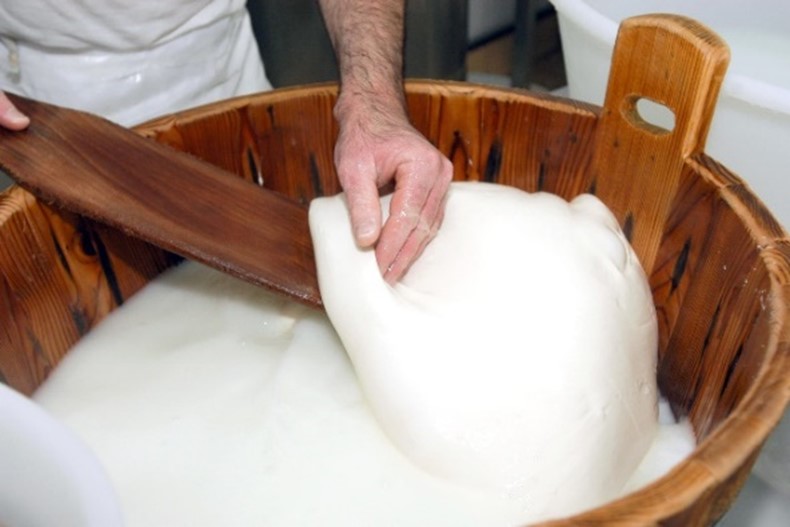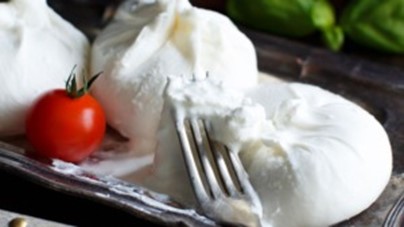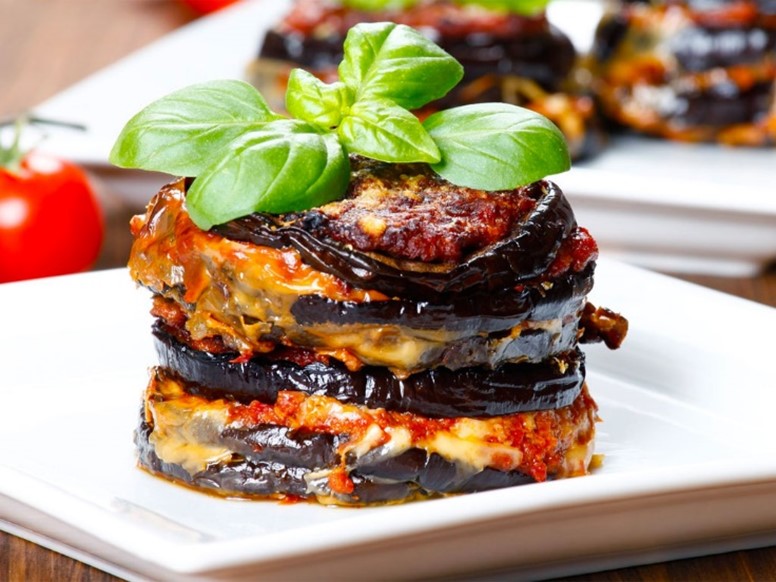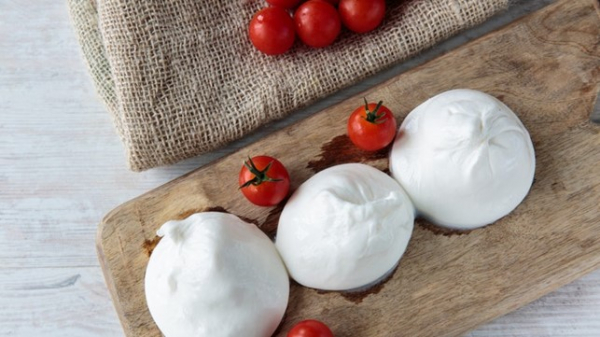HOW MOZZARELLA IS "MADE"
So, let us lead you to discover buffalo mozzarella, starting with its name. First of all, why is it called “mozzarella”? The name derives from the term 'mozzare', which in Italian indicates the action of cutting, with reference to the manual cut made with index and thumb, starting from the still hot stretched curd, to create the shape of the cheese itself. This practice, carried out manually, is essential to give the cheese its characteristic shape and consistency.
How is buffalo mozzarella produced, or rather, how is it "created"? Because the production process includes a "manual" step, without which buffalo mozzarella would not exist, so someone "creates" mozzarella with their own hands, and this someone is "Mastro Casaro", the Cheese Master. It starts with buffalo milk, which is heated; then, natural lactic ferments are added due to the previously processed whey, which will transform the milk into rennet. Once coagulation has occurred, after a resting period, the curd is stretched and processed manually in water at 95°C (203°F), until they obtain the right consistency. Stretching the curd causes a protein thickening of the milk, giving an elastic but not rubbery structure to the almost finished product. Finally, the curd is "cut" to obtain the desired size and is preserved in brine.
Buffalo mozzarella can be rounded or "braided", also called "knot". The colour is porcelain white; the texture seems soft and characterized by a thin "skin", and when cut, it releases abundant serum.
The rule for storage is only one but very important: mozzarella must be preserved in its whey. However, if you decide to use it for your pizza, drain its whey one hour before its use and keep it in the fridge, so as not to water down the pizza dough during its cooking.

THE HISTORY OF MOZZARELLA
Before the Middle Ages, mozzarella's origins are clouded by myth. It is believed that Greek settlers in "Magna Graecia" (Southern Italy) pioneered a cheese-making technique similar to mozzarella. Buffalo, present in Italy since prehistoric times, was initially used for labour due to its resilience, not for milk. Only in medieval times, when monks at the San Lorenzo monastery in Capua began using buffalo milk to create "mozza" cheese, did the production of buffalo milk cheese become significant. Mozzarella gained popularity in the Late Middle Ages with thriving markets in Southern Italy, though its perishability limited its reach. In 1570, chef Bartolomeo Scappi mentioned mozzarella in a recipe, signalling its cultural importance.
Mozzarella’s popularity spread through trade routes and was particularly enjoyed by Charles of Bourbon, who established a buffalo farm at the Royal Palace of Carditello in 1744. Despite its rising fame, mozzarella remained primarily local until Italy’s unification in 1860. However, Northerners viewed mozzarella with suspicion, perceiving it as a product tied to the Southern peasantry.
The 1981 establishment of the Consortium for the Protection of Mozzarella di Bufala Campana, alongside improved storage methods, expanded Mozzarella’s reach across Italy and internationally. In 1996, it earned the “DOP” (Protected Designation of Origin) status. Its unique taste, freshness, and versatility, coupled with its association with pizza, contributed to mozzarella’s worldwide popularity.

MOZZARELLA IS PROTECTED
The TSG mark, or "Traditional Specialty Guaranteed", protects this excellent typical Italian product. In addition, buffalo mozzarella is a PDO product, which means it cannot be produced elsewhere with ingredients or processes different from the originals. The PDO area covers Campania with parts of Puglia and especially Lazio, where an excellent mozzarella is made.

Given its popularity, mozzarella, especially buffalo mozzarella, is copied worldwide from the United States to China. If you want to recognize an original buffalo mozzarella from the various imitations, look for the production area on the label: you will find Italy, Campania, Puglia, Lazio and the provinces of Naples, Salerno, Latina, Frosinone and Foggia.

THE RELATIVES OF BUFFALO MOZZARELLA: FIORDILATTE AND BURRATA
For Buffalo Mozzarella from Campania and Fiordilatte, the production process is the same, the difference lies in the fundamental ingredient: buffalo milk is used for one, cow's milk for the other. The consistency of the latter is slightly different: Fiordilatte has a more fibrous paste, and when cut, it releases a more transparent milky liquid, while the film is somewhat thinner. Until 1996, both were sold under the term "mozzarella", but the PDO reserved the term for the one produced with buffalo milk. Same technique, different raw materials.
The third jewel of the art of cheese-making in Southern Italy is "Burrata". There is a big difference between mozzarella and burrata, which does not catch the eye until you cut them with a knife.
While the origin of mozzarella is lost in the mists of time, burrata has a precise place and date of birth, and even a father, or rather an inventor, recognized: Andria, in Puglia, 1956. Its inventor was Lorenzo Bianchino. That year, a tremendous snowfall had made it difficult to transport dairy products; so, the ingenious cheesemaker of the Piana Padula farm, near Castel del Monte, thought of using the stretched curd of mozzarella as a wrapper to store cream and frayed mozzarella. And so burrata was born, a fresh version of “mantèche”, lightly seasoned stretched curd cheeses with butter filling (hence the name "burrata", from "burro", butter).
 Burrata is produced starting from the stretched curd of mozzarella; in this case, it does not represent the substance of the dairy product but acts as a wrapper. Inside, the master cheesemaker introduces a soft and creamy filling, a frayed spun curd mixed with cream, “stracciatella”. If the first has a more delicate flavour and a more elastic consistency, the second is much softer and savoury but also more caloric, given the presence of cream. To recognize burrata, cut it and see if soft stracciatella comes out. On the palate, the flavour must be fresh and not acidic. The best way to enjoy Burrata is by eating the two parts together, to combine the outside's flavour with the inside's freshness. A delight for the palate!
Burrata is produced starting from the stretched curd of mozzarella; in this case, it does not represent the substance of the dairy product but acts as a wrapper. Inside, the master cheesemaker introduces a soft and creamy filling, a frayed spun curd mixed with cream, “stracciatella”. If the first has a more delicate flavour and a more elastic consistency, the second is much softer and savoury but also more caloric, given the presence of cream. To recognize burrata, cut it and see if soft stracciatella comes out. On the palate, the flavour must be fresh and not acidic. The best way to enjoy Burrata is by eating the two parts together, to combine the outside's flavour with the inside's freshness. A delight for the palate!
THE BEST RECIPES WITH MOZZARELLA
Mozzarella is a very versatile product and can be paired with many foods of any kind. Needless to say, the most famous dish with mozzarella is Pizza Margherita, both in the high "Neapolitan" and the low "Roman" version, where the mozzarella blends harmoniously with tomato and basil, celebrating the colours of the Italian flag.
Apart from Pizza, the best-known dish is undoubtedly the classic “Caprese”, in which fresh mozzarella is accompanied by tomatoes, basil and olive oil, creating a perfect combination of flavours.
 For those of you like me who love stringy and crunchy mozzarella, the "Mozzarella in Carrozza" is a real whim, with mozzarella, sliced bread, eggs and breadcrumbs. It is a typical recipe of Campania and Lazio cuisine, simple to cook that involves frying breaded slices of mozzarella. The name of this recipe derives from the "carriage" that "transports" the protagonist, that is, the crispy and golden breading that wraps the mozzarella. The result? Sleek and amazing!
For those of you like me who love stringy and crunchy mozzarella, the "Mozzarella in Carrozza" is a real whim, with mozzarella, sliced bread, eggs and breadcrumbs. It is a typical recipe of Campania and Lazio cuisine, simple to cook that involves frying breaded slices of mozzarella. The name of this recipe derives from the "carriage" that "transports" the protagonist, that is, the crispy and golden breading that wraps the mozzarella. The result? Sleek and amazing!
 And finally, last but not least, the queen of recipes with mozzarella, a symbol of Italian gastronomy famous all over the world: the "Parmigiana di Melanzane", otherwise known as "Melanzane alla Parmigiana" or simply "Parmigiana". The origins of this dish are disputed between Sicily, Naples and Parma: more clues lead to Sicily, first of all, the name that would recall the term "parmiciana", which in Sicilian speech indicates the arrangement of the wooden strips that form a shutter. According to tradition, the recipe for eggplant Parmigiana calls for fried eggplant arranged in layers, each covered with tomato sauce, mozzarella, parmesan and basil. Cooking is done in the oven.
And finally, last but not least, the queen of recipes with mozzarella, a symbol of Italian gastronomy famous all over the world: the "Parmigiana di Melanzane", otherwise known as "Melanzane alla Parmigiana" or simply "Parmigiana". The origins of this dish are disputed between Sicily, Naples and Parma: more clues lead to Sicily, first of all, the name that would recall the term "parmiciana", which in Sicilian speech indicates the arrangement of the wooden strips that form a shutter. According to tradition, the recipe for eggplant Parmigiana calls for fried eggplant arranged in layers, each covered with tomato sauce, mozzarella, parmesan and basil. Cooking is done in the oven.
Lovers of good Italian food, get ready, we are waiting for you for a high-level meeting with a true protagonist of Italian cuisine. It will not disappoint you! And please, I beg you: Italian mozzarella, no "mazzarilla".
Ciao da Marcello
